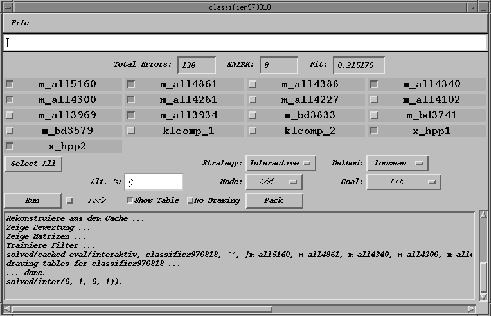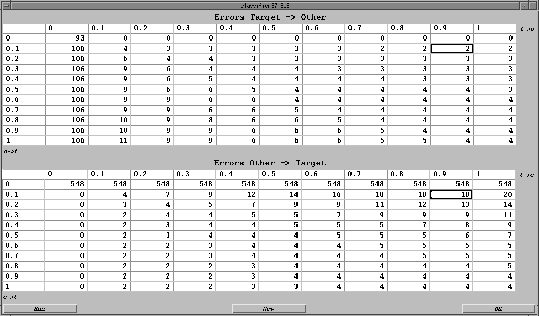Next: Information Mining in Astronomical Literature with Tetralogie
Up: Astrostatistics and Databases
Previous: Noise Detection and Filtering using Multiresolution Transform Methods
Table of Contents -- Index -- PS reprint -- PDF reprint
Astronomical Data Analysis Software and Systems VII
ASP Conference Series, Vol. 145, 1998
Editors: R. Albrecht, R. N. Hook and H. A. Bushouse
N. Christlieb1 and L. Wisotzki
Hamburger Sternwarte, Gojenbergsweg 112, D-21029 Hamburg, Germany
G. Graßhoff
Institut für Wissenschaftsgeschichte, Georg-August-Universität
Göttingen
A. Nelke and A. Schlemminger
Philosophisches Seminar, Universität Hamburg
1E-mail: nchristlieb@hs.uni-hamburg.de
Abstract:
We report on the software system LINNé, which has been designed for
the development and evaluation of classification models. LINNé is used
for the exploitation of the Hamburg/ESO survey (HES), an objective prism
survey covering the entire southern extragalactic sky.
The Hamburg/ESO survey (HES) was originally conceived as a wide angle
objective prism survey for bright quasars. It is carried out with the ESO
Schmidt telescope and its  prism and covers the total southern
extragalactic sky. For a description of the survey see
Wisotzki et al. (1996).
prism and covers the total southern
extragalactic sky. For a description of the survey see
Wisotzki et al. (1996).
A few years ago we started to develop methods for the systematic
exploitation of the stellar content of the survey by means of
automatic spectral classification. A short overview of the scientific
objectives is given in Christlieb et al. (1997) and Christlieb et
al. (1998), where also a detailed description of the classification
techniques can be found. In this paper we report on the software system
LINNé, that has been designed for the development and evaluation of
classification models.
A classification model (CM) consists of the following components:
- Class definitions
- are given by means of a learning sample,
implicitly including the number N and names of the defined classes.
- Class parameters
- include the a priori probabilities
 , of the N defined classes and the parameters
of the multivariate normal distribution of the class-conditional
probabilities
, of the N defined classes and the parameters
of the multivariate normal distribution of the class-conditional
probabilities  .
. - Classification aim
- can be one of the following items:
- (1)
- Perform a ``simple'', i. e. Bayes-rule classification.
- (2)
- Compile a complete sample of class
 with minimum cost rule
classification.
with minimum cost rule
classification.
- (3)
- Detect ``un-classifiable'' spectra, i. e. spectra to which the
reject option (Christlieb et al. 1998) applies. Note that e. g. quasar
spectra belong to this class.
- Feature space
- The space of features in which the search for the
optimal subset is carried out. Note that in certain cases one may want to
exclude available features beforehand to avoid biases, so that the
feature space is not necessarily identical to the total set of
available features.
- Optimal feature set
- for the given classification aim.
- Optimal loss factors
- In case of classification aim (3) a set of
three optimal loss factors - weights for different kinds of
misclassifications - has to be stated (Christlieb et al. 1998).
Once a CM is established, it is straightforward to derive from it a
classification rule for the assignment of objects of unknown classes
to one of the defined classes.
The aim of LINNé is to permit easy and well controlled access to the
variation of the model components and effective means to evaluate the
resulting quality of classification. The performance of a model with
classification aim (1) can be evaluated by e. g. the total number of
misclassifications, estimated with the leaving-one-out method (Hand
1981); in case of aim (3) the model is usually assessed by the number of
misclassifications between the target class and the other classes.
The core of LINNé was implemented in an object-oriented extension to
Prolog, with the numerical routines - e. g. for estimation of the parameters
of the multivariate normal distributions - written in C. To facilitate user
interaction and to ensure effective control over the model components and
performance, a graphical user interface (GUI) for LINNé was developed
(see Figure 1).
Figure 1:
Main control panel of LINNé. The
three upper text fields show model performance parameters. Below them the
feature selection area is placed (m_all5160...x_hpp2).
The automatic feature selection is controlled by the menus above the
Prolog server messages window.
 |
After the first implementation, using Prolog's own graphical library
(SWI-Prolog plus XPCE), we recently started to switch to Java for reasons
of system independence and remote access via WWW. At present, LINNé has
a server-client architecture, the Prolog server communicating with a Java
client through TCP/IP sockets. The server keeps the learning sample data,
read in from MIDAS via an interface and converted into Prolog readable
terms. It is not yet possible to select all model components
interactively via the GUI, so that partly pre-designed models have to be
used. They are also provided from the server side.
The results of the classification model evaluation are presented on the
client. A confusion matrix and loss matrix window assists the user in the
analysis of the model. The user may then alter components and repeat the
evaluation to improve the model step by step.
The search for the optimal feature set can also be done automatically.
Since the set of available features may easily become too large to perform
exhaustive search among all possible combinations, apart from the
exhaustive search a hill-climbing like, stepwise search has been
implemented. It can be controlled from the client side, using different
strategies and branching parameters.
LINNé also provides a tool for the systematic and efficient adjustment
of loss factors (see Figure 2).
Figure 2:
Tool for interactive adjustment of loss
factors. The upper half of the window shows the number of target class
spectra which have been erroneously assigned to one of the other
classes in dependence of the loss factors  (abscissa) and
(abscissa) and  (ordinate). The
lower half shows the same for the target class contamination.
The third loss factor,
(ordinate). The
lower half shows the same for the target class contamination.
The third loss factor,  , does not have to be
adjusted but can be held constant at a small value.
, does not have to be
adjusted but can be held constant at a small value.
 |
Once a CM has been established, evaluated, and the evaluation has pleased
the user, its parameters can be exported to MIDAS tables. The
classification of spectra of unknown classes can then be carried out under
MIDAS. The typical computing time for the classification of all spectra on
one HES plate - mapping  of the sky and yielding
typically
of the sky and yielding
typically  non-disturbed spectra with S/N>10 - is less
than 5 min on a Linux PC with a Pentium 133 MHz processor.
non-disturbed spectra with S/N>10 - is less
than 5 min on a Linux PC with a Pentium 133 MHz processor.
So far LINNé has been used for some first test applications, i. e.
compilation of a sample of extremely metal poor halo stars and a search for
FHB/A stars. It will be developed further and extended in functionality and
will be applied to the exploitation of the huge HES data base, which will
finally consist of  digitised objective prism spectra.
digitised objective prism spectra.
Acknowledgments:
N.C. acknowledges an accommodation grant by the conference organizers. This
work was supported by the Deutsche Forschungsgemeinschaft under grants
Re 353/40-1 and Gr 968/3-1.
References:
Christlieb, N. et al. 1997, in Wide-Field Spectroscopy, ed.
Kontizas, E. et al., Kluwer, Dordrecht, 109
Christlieb, N. et al. 1998, to appear in Data Highways and
Information Flooding, a Challenge for Classification and Data Analysis,
ed. Balderjahn, I. et al., Springer, Berlin.
Hand, D. 1981, Discrimination and Classification, Wiley &
Sons, New York.
Wisotzki, L. et al. 1996, A&AS, 115, 227
© Copyright 1998 Astronomical Society of the Pacific, 390 Ashton Avenue, San Francisco, California 94112, USA
Next: Information Mining in Astronomical Literature with Tetralogie
Up: Astrostatistics and Databases
Previous: Noise Detection and Filtering using Multiresolution Transform Methods
Table of Contents -- Index -- PS reprint -- PDF reprint
payne@stsci.edu
 with minimum cost rule
classification.
with minimum cost rule
classification.

